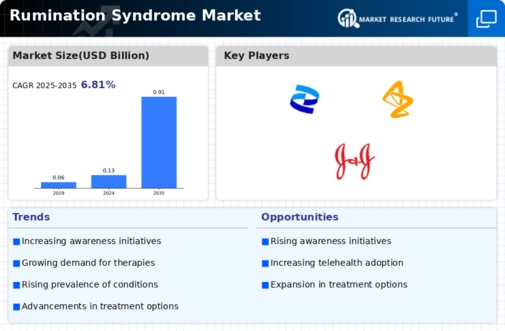Increased Research Funding
The allocation of increased research funding for gastrointestinal disorders, including rumination syndrome, is likely to bolster the Rumination Syndrome Market. Government and private institutions are recognizing the need for more in-depth studies to understand the underlying mechanisms of this condition. This influx of funding may lead to the development of novel diagnostic tools and treatment strategies, ultimately improving patient outcomes. Furthermore, as research progresses, it could pave the way for greater public awareness and education about rumination syndrome, encouraging more individuals to seek treatment and thereby expanding the market.
Advancements in Treatment Options
Innovative treatment modalities are emerging as a key driver in the Rumination Syndrome Market. Recent advancements in behavioral therapies, pharmacological interventions, and nutritional counseling have shown promise in managing symptoms effectively. For instance, cognitive-behavioral therapy has gained traction as a preferred approach, with studies suggesting a significant reduction in rumination episodes among patients. Additionally, the introduction of new medications targeting gastrointestinal motility may enhance treatment efficacy. As these advancements continue to evolve, they are likely to attract investment and research, further propelling the market forward and providing patients with more comprehensive care options.
Rising Incidence of Rumination Syndrome
The increasing prevalence of rumination syndrome appears to be a significant driver for the Rumination Syndrome Market. Recent studies indicate that the condition affects a notable percentage of the population, particularly among adolescents and young adults. This rise in incidence may be attributed to various factors, including lifestyle changes and dietary habits. As awareness grows, healthcare providers are more likely to diagnose and treat this condition, leading to a surge in demand for therapeutic options. The market is projected to expand as more individuals seek help for this often-misunderstood disorder, thereby creating opportunities for pharmaceutical companies and healthcare providers to innovate and offer tailored solutions.
Growing Multidisciplinary Treatment Approaches
The adoption of multidisciplinary care approaches is becoming increasingly prevalent in the Rumination Syndrome Market. Healthcare providers are recognizing that effective management of rumination syndrome often requires collaboration among various specialists, including gastroenterologists, psychologists, and dietitians. This holistic approach not only addresses the physical symptoms but also considers the psychological and nutritional aspects of the disorder. As more healthcare systems implement these collaborative models, patients may experience improved outcomes, which could lead to a higher demand for integrated treatment solutions and services within the market.
Rising Awareness Among Healthcare Professionals
The growing awareness of rumination syndrome among healthcare professionals is a crucial driver for the Rumination Syndrome Market. As medical education increasingly incorporates information about this condition, practitioners are better equipped to recognize and diagnose it. This heightened awareness may lead to earlier interventions and more effective management strategies, ultimately benefiting patients. Additionally, as healthcare providers become more informed about the available treatment options, they are likely to refer patients to specialized care, further stimulating market growth. The trend suggests a positive shift in the healthcare landscape regarding the understanding and treatment of rumination syndrome.














Leave a Comment